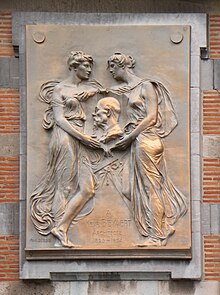Henri Beyaert
| Hendrik (Henri) Beyaert | |
|---|---|
 |
|
| Born |
29 July 1823 Kortrijk, Belgium |
| Died | 22 January 1894 (aged 70) Brussels, Belgium |
| Nationality | Belgian |
| Occupation | Architect |
| Buildings |
Head Office of the National Bank of Belgium, in Brussels |
Head Office of the National Bank of Belgium, in Brussels
Office of the National Bank of Belgium in Antwerp
Tournai Railway Station
Hendrik Beyaert (Dutch) or Henri Beyaert (French) (29 July 1823 in Kortrijk, Belgium – 22 January 1894 in Brussels) was a Belgian architect.
He is considered one of the most important Belgian architects of the 19th-century.
Hendrik Beyaert was of very humble descent. For this reason he had to earn his living from a very young age onwards. Initially he and his family couldn't afford to finance higher studies. At age 19, Hendrik Beyaert worked as a bank employee at the National Bank of Belgium's office in Kortrijk. He found his profession not very indulging and decided to quit the bank. As he had always been fascinated by architecture he found a post as an apprentice stonemason on the building site of the new railway station of Tournai, a building that would be replaced decades later by a design of Hendrik Beyeart himself.
In 1842 the young man went to Brussels where he kept a small bookshop to earn his living and where he enrolled at the Académie to attend the architecture courses. In the following year he met the architect Félix Janlet who believed in the young Beyaert's exceptional qualities and who offered him a job in his office. Due to this job and to a small scholarship granted to him by his native city Kortrijk, Beyaert could finish his architectures studies at the Académie Royale des Beaux-Arts which he completed in 1846. At the Académie he studied with Tilman-François Suys by whom he was largely influenced during the first years of his career as an independent architect. Beyaert gradually moved away from the neo-classical style if his master and began to experiment with a neo-Louis XVI style in the mansions he built along the Brussels Avenue des Arts and Chaussée de Charleroi.
His first public commission was the head-office of his former employer, the "Banque Nationale de Belgique". This cooperation with the architect Wynand Janssens resulted in a lavish neo-baroque building heavily influenced by the new style propagated in Paris, known as Second Empire. The critical success that it enjoyed, together with Beyaert’s connections with the powerful Liberal Party, led to many other commissions, beginning with the De Brouckère fountain (1866), now on the Square Jan Palfijn, Laeken. Other major works followed in rapid succession. In his major renovation projects of medieval buildings, such as the "Hallepoort" (or "Porte de Hal", a vestige of the medieval fortifications of Brussels) he was influenced by the French architect and theoretician Viollet-le-Duc. This realisation played an important role in Beyaert's architectural development for it made him aware of the importance and beauty of the local architectural styles from the late middle-ages and the early renaissance. Beyaert's style largely shifted to the so-called "Flemish Renaissance Revival" which partly under his influence would become a very popular "National" style in the last quarter of the 19th-century. Other works included the Antwerp Office of the National Bank of Belgium building (1874–79), built on a clever triangular plan, the Tournai Railway Station (1875–79, damaged in WWII), and the Kegeljan-Godin house (1878–1880) in Namur. All had a similar, vaguely Flemish Renaissance or Baroque Revival flavour. In 1876 however, Beyaert publicly denied being a partisan of the nascent Flemish Renaissance Revival movement in Belgium, although the proponents of this movement had wished to align his creations to their own.
...
Wikipedia
